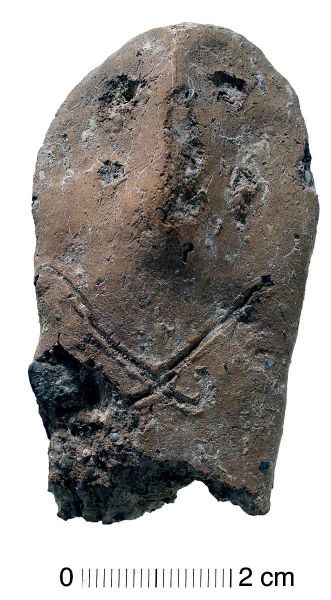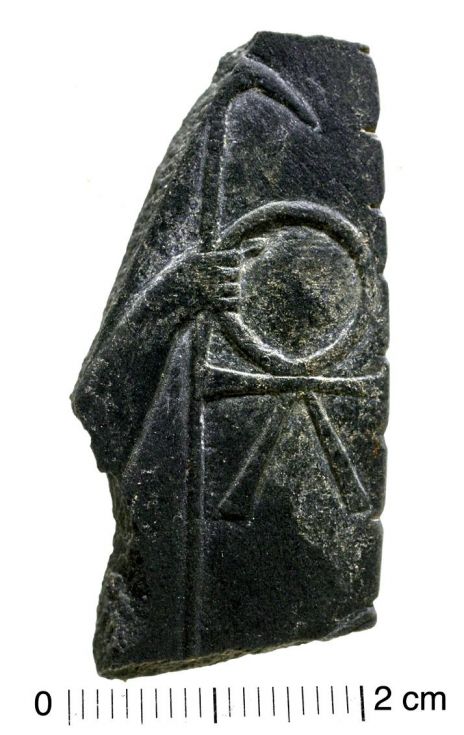A fragment of a stone tablet bearing ancient Egyptian symbols is the highlight of the second season of excavations at Tel Beit Yarah in joint excavations by Tel Aviv University and the University of London

A fragment of a stone tablet bearing ancient Egyptian symbols is the highlight of the second season of excavations at Tel Beit Yarah (Khirbat al-Karach). The mound, at the outlet of the Jordan from the Sea of Galilee, sits on an ancient road that connected Egypt with the rest of the ancient East. The excavation season, which ended last week, is the result of a collaboration between Tel Aviv University and the Institute of Archeology of the University of London (UCL. The director of the excavation, Dr. Rafi Greenberg, and the head of the UCL delegation, Dr. David Vangro, stated that the fragment of the tablet, which is about 4 cm, is the first of its kind that has ever been found at an archaeological site outside of Egypt. It can be seen in the relief of a hand holding a staff and an early version of the Egyptian Ankh symbol, and can even be attributed to the reign of the First Dynasty in Egypt around 3000 BC, or shortly after Then. Findings of this type are rare in Egypt itself. The symbols are made of high quality, and can be compared to the symbols that appear on royal grinding plates and other relics from the founding period of the Egyptian monarchy. Previous findings, both in Beit Yarah and in Egypt, have already indicated direct contact between the site - one the great ones in the Jordan Valley - and the Egyptian royal court. The new find suggests that these connections had the greatest local significance.

This year's excavations shed new light on relations with the far north as well, and this is due to the discovery of considerable quantities of "moon ware" (a unique type of pottery painted in red and black tones) in connection with mobile pottery kilns, some of which were decorated with the image of a human face. "The brothers are very similar to objects found in Anatolia and the South Caucasus," noted Greenberg, "and most of them were found in open areas where there was evidence of other fire-related activities. The consumers of these pottery were probably immigrants or descendants of immigrants, and the distribution of the vessels at the site as well as the study of other aspects of their culture - their favorite foods or the way they organized their homes - may teach about their connections with the natives of the place and their adaptation to the new environment."
Another focus of the excavations was the large fortified structure which has been identified by experts in early Islamic history as the Umayyad Palace of A-Zinbara. Colorful mosaic floors, which were discovered many years ago but were covered and hidden from view, were cleaned and fully documented for the first time. Wide and deep wall foundations showed that the structure had at least two stages of construction, and that it must have been very tall before it was destroyed and before its stones were transported off site. Some of the walls showed deep cracks that may indicate an earthquake - perhaps the one of 749 CE, which destroyed many buildings along the Jordan Valley.
The buildings that were uncovered in the 2009 season are included in the declared territory of the Beit Yarah National Park, at the northern end of the ancient mound.

8 תגובות
The assumption that it is a human face or an attempt at such is due to comparisons with other examples of humanoid brothers or zoomorphs that belong to a series of lunar vessels and the name of the artist and the level of preservation show a resemblance closer to a human figure
Adam builds:
Now you are punctual.
I think, however, that the question of whether it is a face or something else is less important than the diagnosis that it is something that was deliberately designed.
to be precise,
I doubt that the designer intended to make a figure of a face.
Adam builds:
Your claim is not justified because the "face" on Mars appears as a face only from a certain angle and under certain lighting conditions.
This is not the case with what is shown here which is clearly designed by a human.
It is possible to doubt the intention of that person and his talent, but this is not a coincidence like on Mars.
In short: a human statue - builders 🙂 (and it is not a coincidence)
Raul, it's not relevant to this article.. you can't relate certain things to others in a logical way.
Who said the first is a man?
Maybe it's a monkey?
The apparent human figure that appears in the first picture is not so convincing to me.
For that matter the face on Mars looks just as real.
What heartwarming findings